采用GA-ELM的寒地水稻缺氮量诊断方法
许童羽,郭忠辉,于丰华,徐 博,冯 帅
采用GA-ELM的寒地水稻缺氮量诊断方法
许童羽1,2,郭忠辉1,于丰华1,2,徐 博1,冯 帅1
(1. 沈阳农业大学信息与电气工程学院,沈阳 110161;2.辽宁省农业信息化工程技术中心,沈阳 110161)

光谱分析;模型;高光谱;离散小波多尺度分解;遗传优化算法;极限学习机
0 引 言
在各种营养元素中,氮素对水稻的生长发育和产量影响最大[1-2]。氮素在维持和调节水稻生理功能上具有多方面的作用[3]。水稻缺氮会阻碍叶绿素和蛋白质的合成,从而减弱光合作用,影响干物质的产生,严重缺氮时细胞分化停止,分蘖能力下降、根系机能减弱[4-6]。当水稻氮素过多时,无效分蘖增加,群体容易过度繁茂,致使透光不良,结实率下降,成熟延迟,加重后期倒伏和病虫害的发生[7-9]。
近年来,随着高光谱技术的发展和应用,农业信息技术在农作物长势监测和估产方面得到了长足的发展,显著提高了作物生产的动态检测和管理决策的科学性。作物发育过程中,氮素营养水平的变化会引起叶片颜色、叶绿素水平、水分含量等的变化,进而引起高光谱的变化,这是利用高光谱进行氮素估测的理论基础[10]。很多学者在高光谱反演作物氮素方面做了大量的研究,并取得了一定的成果。陈青春等[11]经研究发现,采用两波段构建植被指数对水稻冠层叶片含氮量进行估测,估测效果较为准确。
人工神经网络具有学习性、容错性以及实时性,对非线性问题的拟合有着无可比拟的优势,能够对许多领域提供有效的技术与理论支持。目前人工神经网络在高光谱反演作物氮素方面的研究也逐渐增多[12]。Yu等[13]结合水稻冠层数据和环境数据建立了水稻叶片氮素含量反演模型。李旭青等[14]利用改进的随机森林算法进行反演建模,估测精度较高,决定系数达到0.81以上。张瑶等[15]采用支持向量机建立了苹果叶片氮素含量预测模型,其测定和验证决定系数达到0.74以上。准确、实时和动态检测作物植株体内的氮素状态,诊断作物体内的氮素丰缺状况,是氮肥处方决策和精准变量作业的前提和基础。宋晓宇等[16]利用扫描式成像光谱仪获取冬小麦长势和小麦叶面积指数,根据目标产量的需氮量和测得的作物吸收氮素的差值,计算出氮肥的施用量。
很多学者在利用高光谱反演作物氮素含量方面做了大量的研究,但是氮素含量这一指标并不能够指导农民进行定量精准施肥,所以该文利用高光谱反演水稻的缺氮量,采用缺氮量这一指标来直观地表示作物长势,并为实施精准施肥提供参考依据。
1 材料与方法
1.1 试验设计
试验于2018年6—9月在辽宁省沈阳市沈北新区清水台镇柳条河村(123°63′E,42°01′N)进行。供测试的水稻品种为秋光。试验田设有4个氮肥梯度处理,N2为当地标准施氮量,在N2的基础上分别增加和减少50%的施氮量,人为造成高低不同的氮肥梯度。4个不同的施氮量分别为N0(不含氮),N1(50 kg/hm2),N2(100 kg/hm2),N3(150 kg/hm2),每个处理4次重复,共设置4×4=16个试验小区。试验田中0~0.5 m耕层土壤中全氮和速效氮质量分数分别为0.154 、104.032 mg/kg。其他按高产栽培管理。分别在水稻的返青期、分蘖期和抽穗期进行数据采集,采集时,在各氮肥梯度处理下选择具有代表性的3穴水稻进行叶片高光谱数据和叶片氮素含量数据的获取,将试验中测得的144组氮素含量数据,采用3倍标准差分别对各个关键生育期氮素含量进行异常值剔除。同时采用蒙特卡洛算法将各关键生育期异常光谱数据剔除,最终得到113个样本,其中训练集79个,验证集34个。如表1所示。
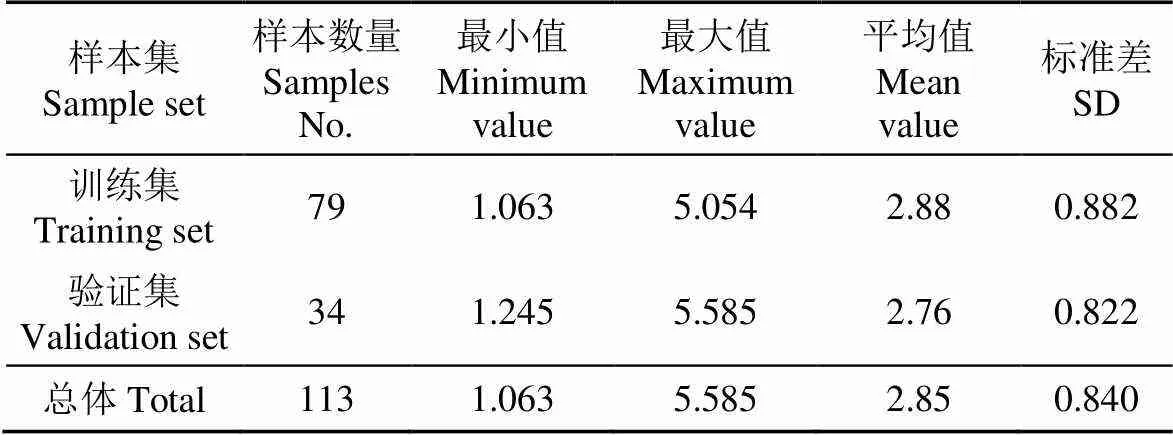
表1 水稻叶片氮素质量分数统计
1.2 数据获取
1.2.1 水稻叶片缺氮量测定以及产量测定
在每个小区中对水稻进行破坏性取样,带回实验室,将该穴水稻所有新鲜叶片剪下置于烘箱中以105 ℃杀青30 min,再以65 ℃烘干至恒量。称量后将其粉碎,把研磨好的粉末分别装入2个做好标记的自封袋中,一袋被用于检测叶片的含氮量(N,mg/g),采用的方法是传统的凯氏定氮法;另一袋被用于采集叶片的高光谱数据。
东北粳稻缺氮量反演建模的前提是构建光谱反射率差值和氮含量差值数据库,而标准光谱反射率和标准氮含量的制定是构建数据库的关键。由于本文的目标是反演出水稻的缺氮量之后,为精准施肥提供参考依据,达到减肥不减产的目的,本研究依据产量最高的原则来制定标准光谱反射率和标准氮含量,在水稻收获时进行测产试验,将产量最高的小区定为标准小区,标准小区的水稻各时期叶片平均光谱和氮含量定为标准光谱反射率和标准氮含量。
10月16日水稻收获时将用pvc管做成的边长为1 m的正方形框随机放入待测小区,计算1 m2内的总穴数、每穴有效穗数、平均每穗粒数以及千粒质量。如表2所示,其中施氮量为N2的水稻田产量最高,达到387.15 kg/667m2。依据产量最高原则,将施氮量为N2的小区定义为标准田,在该小区采集的所有光谱的平均值定义为标准光谱,该小区氮素的平均值定义为标准氮含量。然后对非标准小区采集的水稻叶片氮含量与标准氮含量做差值,完成水稻叶片缺氮量的测定。
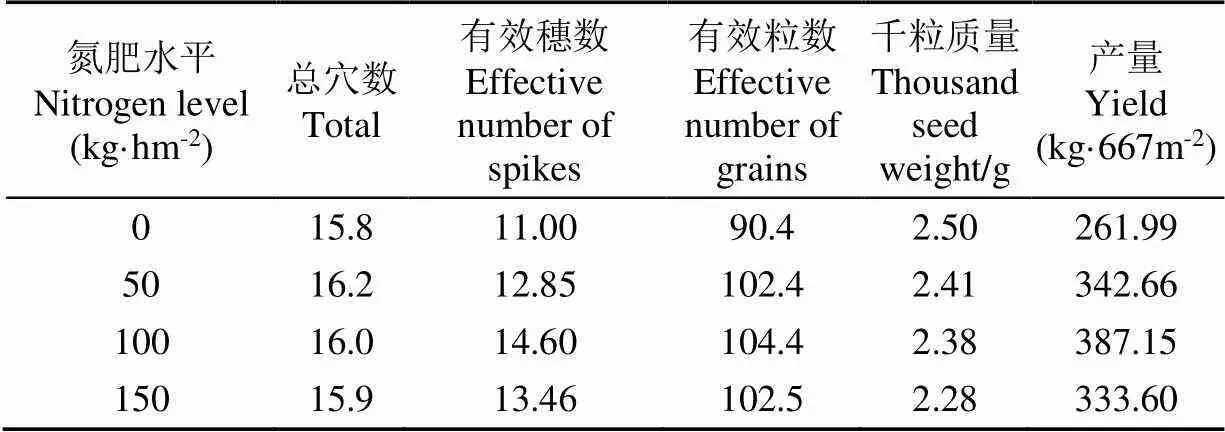
表2 水稻产量统计
回归分析的前提条件是因变量需要满足正态分布,所以该研究对水稻叶片的缺氮量进行正态分布检验,结果如图1和表3所示
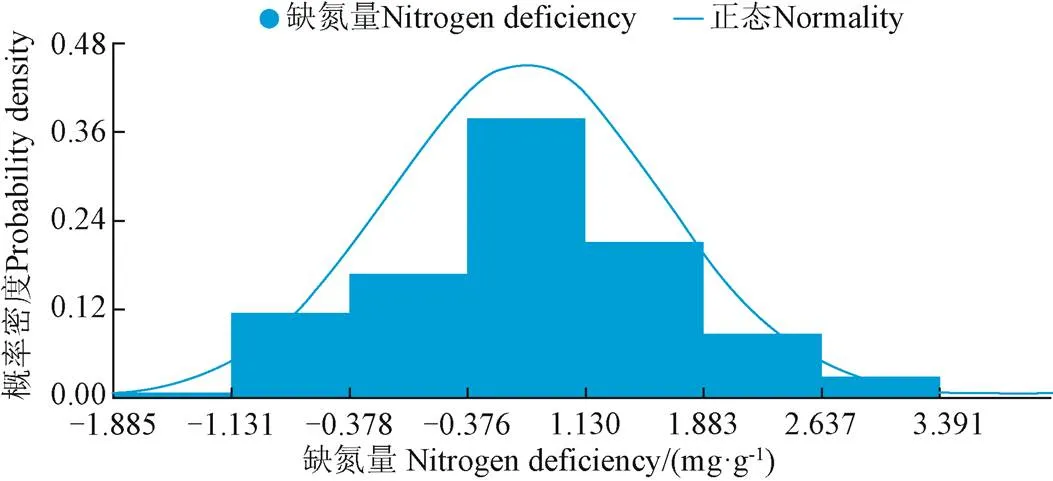
图1 缺氮量正态分布检验

表3 缺氮量正态性检验分析结果
由图1可直观地看出该研究中的缺氮量样本基本呈现正态分布。由表3可知,峰度值和偏度值分别为0.012、0.141,峰度绝对值小于10并且偏度绝对值小于3,说明数据虽然不是绝对正态,但基本可接受为正态分布。大于0.05,意味着缺氮量均没有呈现显著性,说明缺氮量均具备正态性特质。
1.2.2 水稻叶片光谱反射率差值测定
考虑到水稻新鲜叶片水分含量、细胞结构、叶片内含叶绿素等化学组分使得光谱特征评价氮含量变得复杂,所以本研究采用经杀青-烘干-研磨-定型之后纯净的片状氮素样品进行光谱反射率的采集。
水稻叶片经杀青-烘干-研磨之后,为了减少人为使用海洋光学积分球按压水稻叶片氮素粉末力度不均匀导致光谱变化带来的影响,本研究使用天光光学仪器有限公司生产的HY-12液压型红外压片机将粉末状水稻氮素在40 MPa压力下制备成紧密、不透光、厚度一致(半径为7 mm,厚度为3 mm)的片状水稻叶片氮素。然后采用蔚海光学仪器(上海)有限公司生产的海洋光学HR2000+高分辨率光谱仪来测定试验样本水稻叶片氮素的光谱反射率,光谱波段的探测范围为190~1 100 nm,波段精度和光谱分辨率均调整至1 nm。由于190~450和1 000~1 100 nm之间存在着噪声,所以本研究取450~1 000 nm之间的光谱反射率。每次测定叶片光谱反射率前,均要用漫反射参考板对HR2000+高分辨率光谱仪进行校准。
获取水稻叶片光谱反射率之后,对非标准小区采集的水稻叶片光谱反射率与标准光谱反射率做差值,完成光谱反射率差值的测定。光谱反射率差值如图2所示。
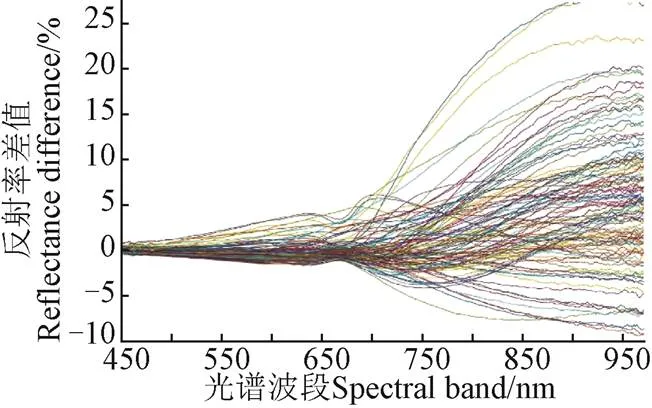
图2 113个光谱反射率差值
1.3 光谱降维方法
全波段光谱中含有大量与各生理生化参数无关的冗余变量,在建模过程中会在一定程度上导致模型误差增大[17-20]。所以,提取光谱数据中的有用信息是建立稳健、准确模型的前提。本研究分别采用离散小波多尺度分解、连续投影法(successive projections algorithm,SPA)和构建植被指数的方法对光谱进行降维处理。
1.3.1 离散小波多尺度分解
小波分析能够在时域和频域上对光谱信号进行精确分解,对于叶片光谱信息,信号在时域上的变换就等同于光谱数据在光谱波段上的变换,因此小波基函数可以表达为





1.3.2 构建植被指数
将400~1 000 nm波段的光谱反射率随机两两组合,构建与水稻叶片缺氮量相关性较高的比值植被指数RVI、归一化光谱指数NDVI和差值植被指数DVI。分别制作RVI、NDVI、DVI与水稻叶片缺氮量的决定系数等势图,寻找较优的3种光谱植被指数作为反演模型的输入。RVI、NDVI、DVI分别定义如下

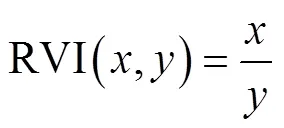
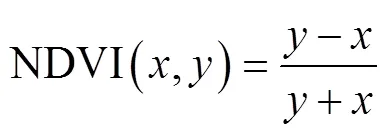
式中,为光谱各波段的反射率,%。
1.3.3 连续投影法
连续投影法(successive projections algorithm,SPA)是一种使矢量空间共线性最小化的前向变量选择算法,现在已被广泛应用于生物医学成像,计算机断层扫描,信号处理,光谱计量学等领域。SPA算法分为以下3个阶段[24]:
第一阶段,筛选出共线性最小的若干组备选波长变量子集。假设初始变量位置(0)及变量数目已经给出,该阶段具体步骤如下。



式中为投影算子。
步骤4:记下投影值范数最大的波长的位置。
()=arg(max||PX||,∈) (8)
步骤5:令X=X,∈
步骤6:令=+1。如果<则返回步骤2
结束:得到个备选波长的位置:{();=0,…,-1}。
选择过程中进行的投影操作次数为(-1)(-/2)。
第二阶段,分别使用各子集中的变量建立多元线性回归(multivariable linear regression,MLR)模型,选出均方根误差(root mean square error,RMSE)最小的子集。
第三阶段,对第二阶段选出的子集进行逐步回归建模,在尽量不损失预测准确度的条件下,得到一个变量数目较少的集合。该集合中的波长变量即是所选有效波长[25-29]。
1.4 反演建模方法
本研究选用偏最小二乘(partial least squares regression,PLSR)、极限学习机(extreme learning machine,ELM)和遗传算法优化极限学习机(genetic algorithm-extreme learning machine GA-ELM)3种方法进行建模,依据检验模型的决定系数R和均方根误差来检验模型的精准度和可靠性,挑选最优的水稻叶片缺氮量反演模型。
ELM以其学习速度快、训练误差小等优点在许多领域得到了广泛的应用。然而该算法随机产生输入层与隐含层间的连接权值及隐含层神经元的阈值,且在训练过程中无需调整,导致该算法所建立的反演模型稳定性和泛化能力较差。本研究采用一种基于进化论优胜劣汰、自然选择、适者生存的物种遗传思想的遗传算法对ELM进行优化。
遗传算法优化训练的具体执行步骤。

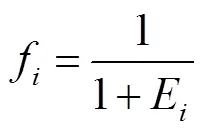
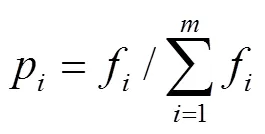


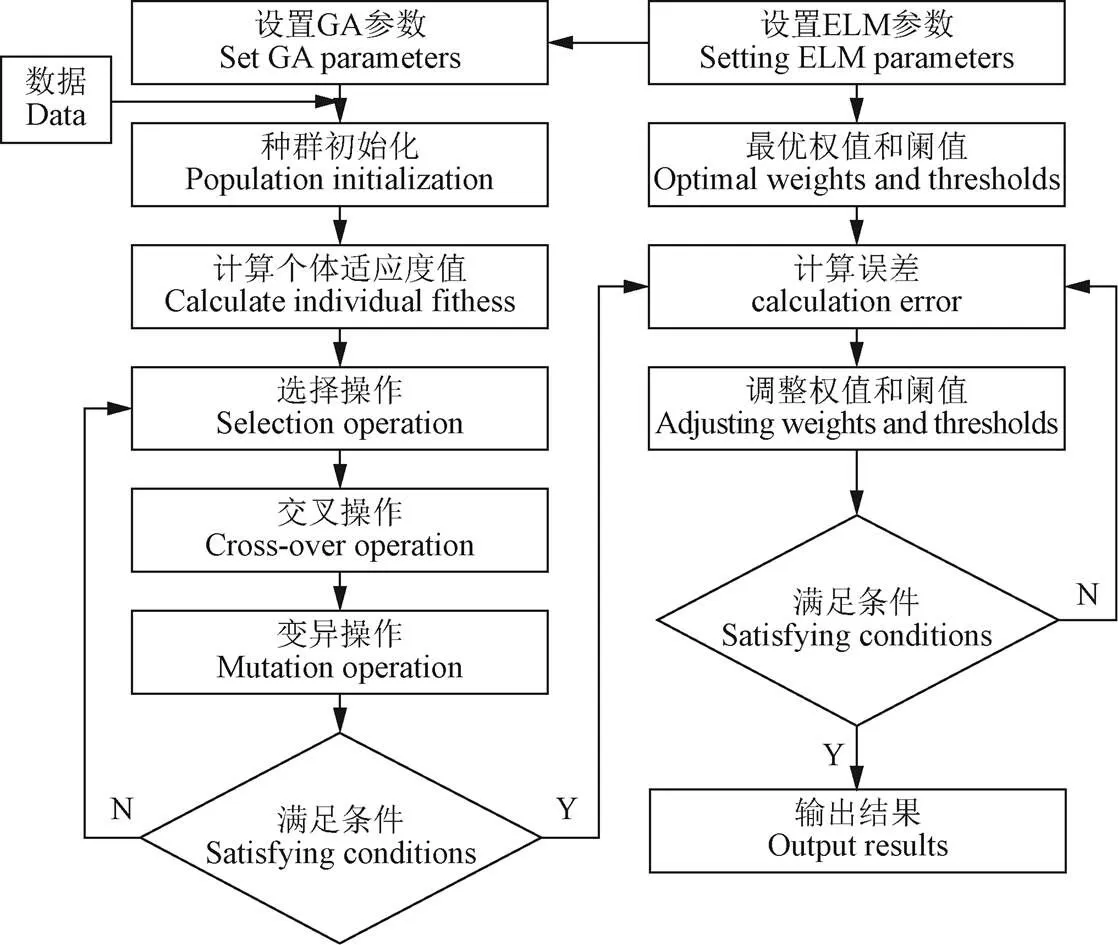
图3 基于GA优化ELM的流程图
2 结果与分析
2.1 特征及特征波段的选择
2.1.1 离散小波多尺度分解选取光谱特征
小波母函数和最佳分解尺度的确定是小波变换进行特征提取的关键环节之一,对光谱信号进行多尺度的离散小波变换,如果分解后的小波信息既能体现光谱的轮廓特性又能达到压缩数据的目的,就可以认为此时的小波母函数和分解尺度是最佳选择。

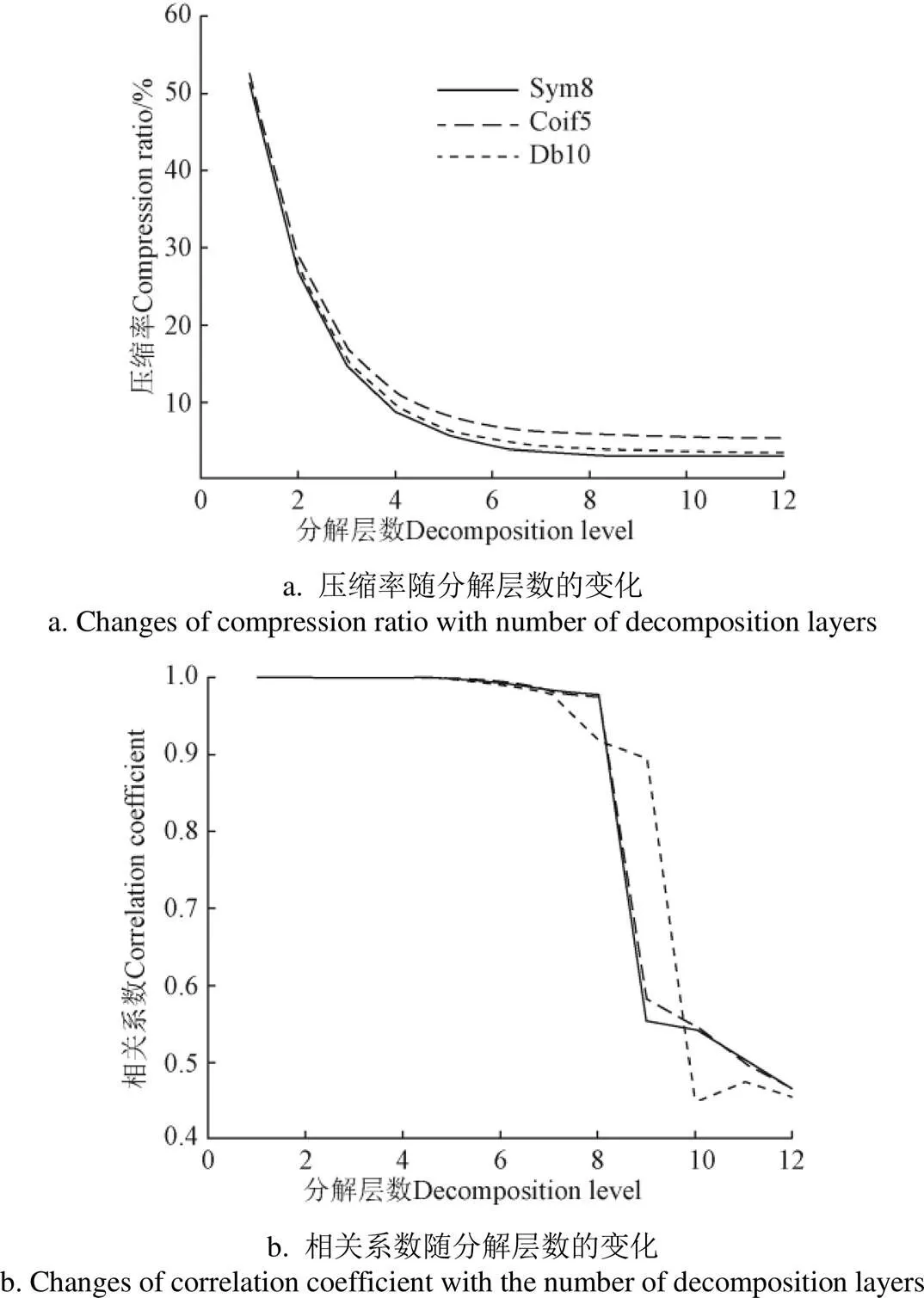
图4 不同小波母函数下的压缩率和相关系数
由表4可知,在分解层数达到10层时,近似系数的数目最终趋于稳定。与其他两类母函数相比,coif5的小波近似系数数目最多,数据压缩能力最弱,其中sym8的小波母函数数据压缩能力最强。由图4可知,db10小波母函数在7~12层的分解中,相关系数变化规律与其他两类小波母函数整体上一致,但是又有所差异。由表可知,在第7层分解后,sym8小波母函数的近似系数数目最少,且相关系数最高。所以综合考虑数据压缩和保留原光谱的能力,认为sym8小波母函数在第7层分解时效果最佳。
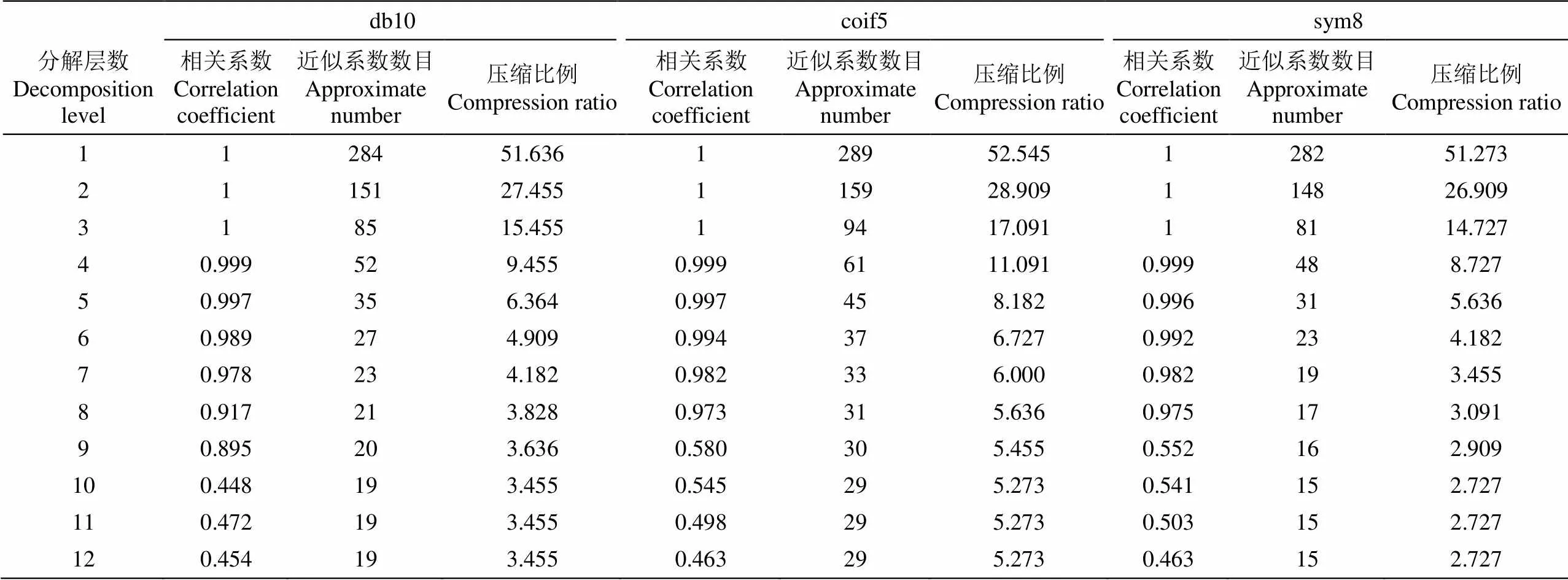
表4 不同小波母函数下的分解个数
对于离散小波变换,低频近似系数反映原始光谱明显的吸收特征,决定整个光谱的形状,所以将分解后的小波近似系数作为模型的输入量。
2.1.2 SPA选取有效特征波段
利用连续投影算法对水稻叶片差值光谱进行光谱特征波段的选择,根据校正集的内部交叉验证RMSECV值确定最佳的光谱波段数为7个,结果如图5a所示。
由图5b可知,利用SPA从400~1 000nm的波段中挑选出7个特征波段,分别为459、460、475、671、723、874和996nm。将挑选出的特征波段处的反射率作为反演模型的输入量。
2.1.3 植被指数与水稻缺氮量的相关性


2.2 遗传算法优化极限学习机反演模型

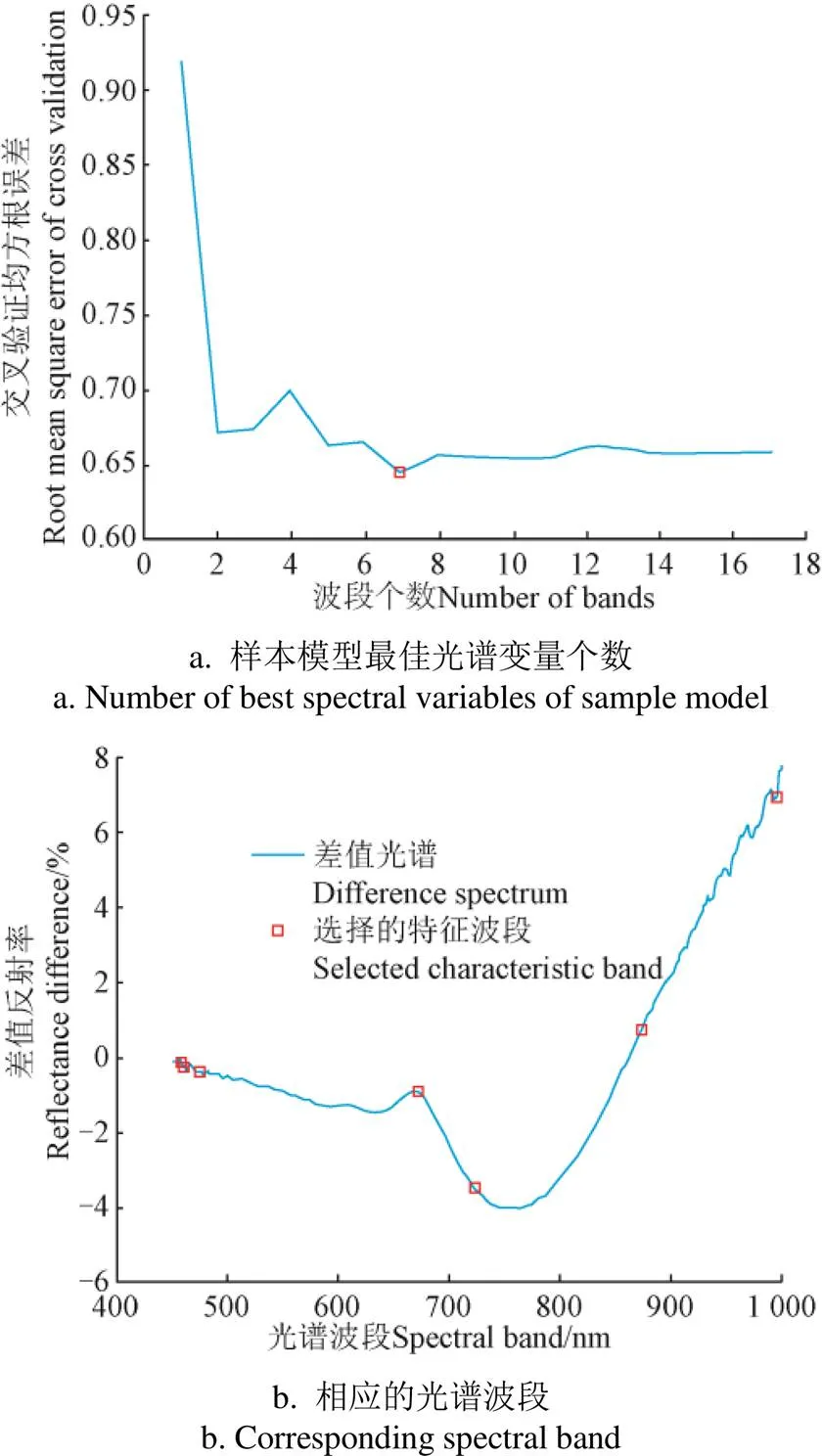
图5 样本模型最佳光谱变量个数和相应的光谱波段

图6 水稻植被指数与缺氮量的决定系数等势图

图7 不同降维方法的GA-ELM水稻叶片缺氮量预测模型检验结果

2.3 与其他反演模型的比较
将遗传算法优化的极限学习机(GA-ELM)与目前在高光谱反演种应用较为广泛的偏最小二乘回归(PLSR)模型和极限学习机(ELM)模型进行比较,建模结果如图8和图9所示。选取与建立GA-ELM模型相同的特征参数作为输入量,且模型参数均调整至最佳状态。

图8 不同降维方法的PLSR水稻叶片缺氮量预测模型检验结果


图9 不同降维方法的ELM水稻叶片缺氮量预测模型检验结果
3 讨 论
本文以东北粳稻为研究对象,构建了粳稻叶片缺氮量与叶片光谱反射率差值,初步确立了粳稻叶片缺氮量的预测模型。考虑到水稻新鲜叶片水分含量、细胞结构、叶片内含叶绿素等化学组分使得光谱特征评价氮含量变得复杂,所以本研究采用经杀青-烘干-研磨-定型之后纯净的片状氮素样品进行光谱反射率的采集,以保证光谱的变化均是由水稻氮素的变化引起的。在数据降维方面,本文采用离散小波多尺度分解、连续投影法和构建植被指数的方法对光谱进行降维处理,将这3种降维方法的结果作为ELM和GA-ELM的建模输入时,基于离散小波多尺度分解得到的小波近似系数建模精度最高。离散小波多尺度分解是将连续小波变换中的尺度及位移进行离散化,并结合小波信号能量在各尺度上的分布,从而对光谱信号维数进行压缩,减少特征波段数目,突出光谱轮廓信息。将小波近似系数进行信号重构,重构光谱信号与原光谱信号的相关系数能够达到0.982,最大程度上保留了原始光谱的信息。在建立模型时,由于小波近似系数与叶片缺氮量的关系更适合用非线性的指数模型来拟合,采用PLSR进行叶片氮含量的线性回归时,严重低估了叶片氮含量的高值,从而降低了模型整体预测精度,导致RMSE误差较大。所以,采用ELM和GA-ELM方法建模时,基于离散小波多尺度分解得到的小波近似系数建模精度最高,而采用PLSR方法建模时,基于小波多尺度分解得到的小波近似系数建模精度最低,且ELM和GA-ELM的建模精度要优于PLSR。GA-ELM模型要优于PLSR和ELM模型,原因在于GA-ELM和ELM模型用非线性函数输入输出数据训练神经网络,使训练后的网络能够预测非线性函数输出,可以有效解释非线性的问题;而GA-ELM模型的反演精度优于ELM模型,是因为GA的优化训练可以为ELM的初始权值进行赋值,对ELM随机产生权值的问题进行优化,提高了模型精度、稳定性和泛化性。
4 结 论
本文中,破坏采样获取返青期、分蘖期和抽穗期的粳稻叶片,在实验室经杀青-烘干-研磨-定型之后,采集粳稻叶片的高光谱数据。
1)依据产量最高的原则确定标准光谱反射率和标准氮含量,在此基础上构建光谱反射率差值和氮含量差值数据库。
2)对光谱反射率差值经SPA(successive projections algorithm)、离散小波多尺度分解、构建植被指数的方法进行降维处理。
3)将3种方法的降维结果分别采用PLSR(partial least squares regression)、ELM(extreme learning machine)、GA-ELM(genetic algorithm-extreme learning machine)方法建立模型。结果表明:

[1] 赵春江. 农业遥感研究与应用进展[J]. 农业机械学报,2014,45(12):277-293. Zhao Chunjiang. Research and application progress of agricultural remote sensing[J].Transactions of The Chinese Society for Agricultural Machinery, 2014, 45(12): 277-293. (in Chinese with English abstract)
[2] 李粉玲,常庆瑞. 基于连续统去除法的冬小麦叶片全氮含量估算[J]. 农业机械学报,2017, 48(7):179-184. Li Fenling, Chang Qingrui. Estimation of total nitrogen content in winter wheat leaves based on continuous removal method[J]. Transactions of The Chinese Society for Agricultural Machinery, 2017,48(7): 179-184. (in Chinese with English abstract)
[3] Wu Y, Huang M, Warrington D N. Growth and transpiration of maize and winter wheat in response to water deficits in pots and plots[J]. Environmental & Experimental Botany, 2011, 71(1): 65-71.
[4] 王树文,赵越,王丽凤,等. 基于高光谱的寒地水稻叶片氮素含量预测[J]. 农业工程学报,2016,32(20):187-194. Wang Shuwen, Zhao Yue, Wang Lifeng, et al. Prediction of nitrogen content in rice leaves based on hyperspectral data[J]. Transactions of the Chinese Society of Agricultural Engineering(Transactions of the CSAE), 2016, 32(20): 187-194. (in Chinese with English abstract)
[5] Moharana S, Dutta S. Spatial variability of chlorophyll and nitrogen content of rice from hyperspectral imagery[J]. ISPRS Journal of Photogrammetry and Remote Sensing, 2016, 122(3): 17-29.
[6] Dong L, Xue W, Hengbiao Z, et al. Estimation of area-and mass-based leaf nitrogen contents of wheat and rice crops from water-removed spectra using continuous wavelet analysis[J]. Plant Methods, 2018, 14(1): 76-89.
[7] 何勇,彭继宇,刘飞,等. 基于光谱和成像技术的作物养分生理信息快速检测研究进展[J]. 农业工程学报,2015,31(3):174-189. He Yong, Peng Jiyu, Liu Fei, et al. Research progress in rapid detection of crop nutrient physiological information based on spectroscopy and imaging technology[J]. Transactions of the Chinese Society of Agricultural Engineering(Transactions of the CSAE), 2015, 31(3): 174-189. (in Chinese with English abstract)
[8] 史舟,梁宗正,杨媛媛,等. 农业遥感研究现状与展望[J]. 农业机械学报,2015,46(2):247-260. Shi Zhou, Liang Zongzheng, Yang Yuanyuan, et al. Present situation and prospect of agricultural remote sensing research[J]. Transactions of The Chinese Society for Agricultural Machinery, 2015, 46 (2): 247-260. (in Chinese with English abstract)
[9] Lin D, Wei G, Jian Y. Application of spectral indices and reflectance spectrum on leaf nitrogen content analysis derived from hyperspectral LiDAR data[J]. Optics & Laser Technology, 2018, 107: 372-379.
[10] 秦占飞,常庆瑞,谢宝妮,等. 基于无人机高光谱影像的引黄灌区水稻叶片全氮含量估测[J]. 农业工程学报,2016,32(23):77-85. Qin Zhanfei, Chang Qingrui, Xie Baoni, et al. Estimation of total nitrogen content of rice leaves in irrigation area of Yellow River Diversion based on UAV hyperspectral image[J]. Transactions of the Chinese Society of Agricultural Engineering(Transactions of the CSAE), 2016, 32(23): 77-85. (in Chinese with English abstract)
[11] 陈青春,田永超,顾凯健,等. 基于多种光谱仪的水稻前期植株氮积累量监测[J]. 农业工程学报,2011,27(1):223-229. Chen Qingchun, Tian Yongchao, Gu Kaijian, et al. Monitoring of nitrogen accumulation in early rice based on multiple spectrometers[J]. Transactions of the Chinese Society of Agricultural Engineering(Transactions of the CSAE), 2011, 27(1): 223-229. (in Chinese with English abstract)
[12] 李媛媛,常庆瑞,刘秀英,等. 基于高光谱和BP神经网络的玉米叶片SPAD值遥感估算[J]. 农业工程学报,2016, 32(16):135-142. Li Yuanyuan, Chang Qingrui, Liu Xiuying, et al. Remote sensing estimation of SPAD value of Maize Leaves Based on hyperspectral and BP neural network[J]. Transactions of the Chinese Society of Agricultural Engineering(Transactions of the CSAE), 2016, 32(16): 135-142. (in Chinese with English abstract)
[13] Yu F H, Xu T Y, Cao Y L, et al. Models for estimating the leaf NDVI of japonica rice on a canopy scale by combining canopy NDVI and multisource environmental data in Northeast China[J]. Int J Agric & Biol Eng, 2016, 9(5): 132-142.
[14] 李旭青,刘湘南,刘美玲,等. 水稻冠层氮素含量光谱反演的随机森林算法及区域应用[J]. 遥感学报,2014,18(4):923-945. Li Xuqing, Liu Xiangnan, Liu Meiling, et al. Stochastic forest algorithm for spectral inversion of nitrogen content in rice canopy and its regional application[J]. Journal of Remote Sensing, 2014, 18(4): 923-945. (in Chinese with English abstract)
[15] 张瑶,郑立华,李民赞,等. 基于光谱学原理与小波包分解技术预测苹果树叶片氮素含量[J]. 农业工程学报,2013,29(25):101-108. Zhang Yao, Zheng Lihua, Li Minzan, et al. Prediction of nitrogen content in apple leaves based on spectroscopy and wavelet packet decomposition[J]. Transactions of the Chinese Society of Agricultural Engineering(Transactions of the CSAE), 2013, 29(25): 101-108. (in Chinese with English abstract)
[16] 宋晓宇,王纪华,薛绪掌,等. 利用航空成像光谱数据研究土壤供氮量及变量施肥对冬小麦长势影响[J]. 农业工程学报,2004, 20(4):54-58. Song Xiaoyu, Wang Jihua, Xue Xuzhang, et al. Study on the effect of soil nitrogen supply and variable rate fertilization on the growth of winter wheat using air imaging spectral data[J]. Transactions of the Chinese Society of Agricultural Engineering(Transactions of the CSAE), 2004, 20(4): 54-58. (in Chinese with English abstract)
[17] Hengbiao Z, Tao C, Dong L, et al. Combining unmanned aerial vehicle (UAV)-based multispectral imagery and ground-based hyperspectral data for plant nitrogen concentration estimation in rice[J]. Frontiers in Plant Science, 2018, 9(9): 936-952.
[18] 王树文,牛羽新,马昕宇,等. 基于高光谱的抽穗期寒地水稻叶片氮素预测模型[J]. 农机化研究,2019,41(3):164-170. Wang Shuwen, Niu Yuxin, Ma Xinyu, et al. Hyperspectral prediction model of nitrogen in rice leaves at heading stage[J]. Journal of Agricultural Mechanization Research, 2019, 41(3): 164-170. (in Chinese with English abstract)
[19] 王洋,肖文,邹焕成,等. 基于PROSPECT模型的植物叶片干物质估测建模研究[J]. 沈阳农业大学学报,2018,9(1):121-127. Wang Yang, Xiao Wen, Zou Huancheng, et al. Modeling research on estimation of dry matter in plant leaves based on the prospect model[J]. Journal of Shenyang Agricultural University, 2018, 9(1): 121-127. (in Chinese with English abstract)
[20] 刘昌华,王哲,陈志超,等. 基于无人机遥感影像的冬小麦氮素监测[J]. 农业机械学报,2018,49(6):207-214. Liu Changhua, Wang Zhe, Chen Zhichao, et al. Nitrogen monitoring of winter wheat based on UAV remote sensing image[J]. Transactions of The Chinese Society of Agricultural Machinery, 2018, 49(6): 207-214. (in Chinese with English abstract)
[21] 李粉玲. 关中地区冬小麦叶片氮素高光谱数据与卫星影像定量估算研究[D]. 杨凌:西北农林科技大学,2016. Li Fenling. Study on Hyperspectral Data and Satellite Image Quantitative Estimation of Nitrogen in Winter Wheat Leaves in Guanzhong Area[D]. Yangling: Northwest A&F University, 2016. (in Chinese with English abstract)
[22] Chu X, Guo Y J, He J Y, et al. Comparison of different hyperspectral vegetation indices for estimating canopy leaf nitrogen accumulation in rice[J]. Plant & Soil, 2013, 376(1-2): 193-209.
[23] Mário César Ugulino Araújo, Fragoso W D, et al. A variable elimination method to improve the parsimony of MLR models using the successive projections algorithm[J]. Chemometrics and Intelligent Laboratory Systems, 2008, 92(1): 83-91.
[24] 谢亚平,陈丰农,张竞成,等. 基于高光谱技术的农作物常见病害监测研究[J]. 光谱学与光谱分析,2018. 38(7):247-254. Xie Yaping, Chen Fengnong, Zhang Jingcheng, et al. Monitoring of common diseases of crops based on hyperspectral technology[J]. Spectroscopy and Spectral Analysis, 2018, 38(7): 247-254. (in Chinese with English abstract)
[25] 刘明博,唐延林,李晓利,等. 水稻叶片氮含量光谱监测中使用连续投影算法的可行性[J]. 红外与激光工程,2014,43(4):1265-1271. Liu Mingbo, Tang Yanlin, Li Xiaoli, et al. The feasibility of using continuous projection algorithm in the spectral monitoring of nitrogen content in rice leaves[J]. Infrared and Laser Engineering, 2014, 43(4): 1265-1271. (in Chinese with English abstract)
[26] 贺志远,朱艳,李艳大,等. 中国南方双季稻氮营养指数及产量估算模型研究[J]. 南京农业大学学报,2017. 24(1):11-19. He Zhiyuan, Zhu Yan, Li Yanda, et al. Study on nitrogen nutrition index and yield estimation model of double cropping rice in South China[J]. Journal of Nanjing Agricultural University, 2017. 24(1): 11-19. (in Chinese with English abstract)
[27] 谭昌伟,周清波,齐腊,等. 水稻氮素营养高光谱遥感诊断模型[J]. 应用生态学报,2008,19(6):1261-1268. Tan Changwei, Zhou Qingbo, Qi La, et al. Hyperspectral remote sensing diagnosis model of rice nitrogen nutrition[J]. Chinese Journal of Applied Ecology, 2008, 19(6): 1261-1268. (in Chinese with English abstract)
[28] Inoue Y, Sakaiya E, Zhu Y, et al. Diagnostic mapping of canopy nitrogen content in rice based on hyperspectral measurements[J]. Remote Sensing of Environment, 2012, 126(2): 210-221.
[29] Onoyama H, Ryu C, Suguri M, et al. Potential of hyperspectral imaging for constructing a year-invariant model to estimate the nitrogen content of rice plants at the panicle initiation stage[J]. Ifac Proceedings Volumes, 2013, 46(18): 219-224.
[30] 陈春玲,金彦,曹英丽,等. 基于GA-BP神经网络高光谱反演模型分析玉米叶片叶绿素含量[J]. 沈阳农业大学学报. 2018,18(5):626-632. Chen Chunling, Jin Yan, Cao Yingli, et al. Analysis of chlorophyll content in maize leaves based on GA-BP neural network hyperspectral inversion model[J]. Journal of Shenyang Agricultural University. 2018, 18(5): 626-632. (in Chinese with English abstract)
[31] 章曼,常庆瑞,张晓华,等. 不同施肥条件下水稻冠层光谱特征与叶绿素含量的相关性[J]. 西北农业学报,2015,24(11):53-60. Zhang man, Chang Qingrui, Zhang Xiaohua, et al. Correlation between canopy spectral characteristics and chlorophyll content of rice under different fertilization conditions[J]. Acta Agriculturae Boreali-occidentalis Sinica, 2015, 24(11): 53-60. (in Chinese with English abstract)
[32] Nguyen H T, Lee B W. Assessment of rice leaf growth and nitrogen status by hyperspectral canopy reflectance and partial least square regression[J]. European Journal of Agronomy, 2006, 24(4): 349-356.
[33] 何勇,彭继宇,刘飞,等. 基于光谱和成像技术的作物养分生理信息快速检测研究进展[J]. 农业工程学报,2015,31(3):174-189. He Yong, Peng Jiyu, Liu Fei, et al. Research progress in rapid detection of crop nutrient physiological information based on spectroscopy and imaging technology[J]. Transactions of the Chinese Society of Agricultural Engineering(Transactions of the CSAE), 2015, 31(3): 174-189. (in Chinese with English abstract)
[34] Yu Fenghua, Xu Tongyu, Cao Yingli, et al. Models for estimating the leaf NDVI of japonica rice on a canopy scale by combining canopy NDVI and multisource environmental data in Northeast China[J]. International Journal of Agricultural and Biological Engineering, 2016, 9(5): 132-141.
[35] 李岚涛,马驿,魏全全,等. 基于高光谱的冬油菜植株氮素积累量监测模型[J]. 农业工程学报,2015,27(20):155-164. Li Lan tao, Ma Yi, Wei Quan quan et al. A monitoring model of nitrogen accumulation in winter rape plants based on hyperspectral data[J]. Transactions of the Chinese Society of Agricultural Engineering(Transactions of the CSAE), 2015, 27(20): 155-164. (in Chinese with English abstract)
[36] 张国圣,许童羽,于丰华,等. 基于高光谱的水稻叶片氮素估测与反演模型[J]. 浙江农业学报,2017,33(5):845-849. Zhang Guosheng, Xu Tongyu, Yu Fenghua, et al. Hyperspectral based nitrogen estimation and inversion model for rice leaves[J]. Acta Agriculturae Zhejiangensis, 2017, 33(5): 845-849. (in Chinese with English abstract)
Genetic algorithm combined with extreme learning machine to diagnose nitrogen deficiency in rice in cold region
Xu Tongyu1,2, Guo Zhonghui1, Yu Fenghua1,2, Xu Bo1, Feng Shuai1
(1.,,, 110161,; 2.,, 110161,)
Nitrogen is a key plant nutrient and its deficiency or surplus could inhibit plant growth and reduce crop yield. Over the past decade, remote sensing has been increasingly used to diagnosis nitrogen deficiency in crop. Taking rice grown in cold region in northeast China as an example, this paper studies the relationship between nitrogen content in japonica rice and the difference between spectral reflectance based on data measured from field. This relationship was used to inversely estimate nitrogen deficiency in the rice based on hyperspectral images. In our analysis, the nitrogen content producing the highest yield was defined as standard nitrogen content and its associated spectral reflectance was defied as standard spectral reflectance. The difference between real nitrogen content and the standard nitrogen content, as well as the difference between the real spectral reflectance the standard spectral reflectance, were calculated respectively. The difference in spectral reflectance was dimensionally reduced using the discrete wavelet multi-scale decomposition, continuous projection method (successive projections algorithm, SPA) and vegetation index construction. The characteristic bands screened by SPA were 459、460、475、671、723、874 and 996 nm. Analysis showed that when the discrete wavelet multi-scale decomposition was used to reduce the dimension, the Sym8 wavelet mother function worked best when it was decomposed at the seventh layer. Comparing DVI, NDVI and RVI vegetation index found that the determination coefficient of the DVI index and nitrogen deficiency was significantly higher than that of NDVI and RVI index. The three indexes were used as input to the partial least squares (PLSR), the extreme learning machine (ELM) and genetic algorithm optimization extreme learning machine (GA-ELM). The GA-ELM model was most accurate with the2being 0.7062 for the training set and 0.7594 for the verification set; their associated RMSE was 0.5099mg/g and 0.4276mg/g respectively. The GA-ELM model based on the optimal vegetation index was least accurate, with the2for the training set and the verifying set being 0.6615 and 0.6509 respectively; their associated RMSE was 0.4415mg/g and 0.5312mg/g. Overall, GA-ELM improved stability and predictability of the model compared with PLSR and ELM. It can thus be used as a new method to detect nitrogen content in rice leaf, and has important implication in precision fertilization.
spectrum analysis; models; hyperspectral; discrete wavelet multiscale decomposition; genetic optimization algorithm; extreme learning machine
许童羽,郭忠辉,于丰华,徐 博,冯 帅. 采用GA-ELM的寒地水稻缺氮量诊断方法[J]. 农业工程学报,2020,36(2):209-218. doi:10.11975/j.issn.1002-6819.2020.02.025 http://www.tcsae.org
Xu Tongyu, Guo Zhonghui, Yu Fenghua, Xu Bo, Feng Shuai. Genetic algorithm combined with extreme learning machine to diagnose nitrogen deficiency in rice in cold region[J]. Transactions of the Chinese Society of Agricultural Engineering (Transactions of the CSAE), 2020, 36(2): 209-218. (in Chinese with English abstract) doi:10.11975/j.issn.1002-6819.2020.02.025 http://www.tcsae.org
2019-08-29
2019-12-30
“十三五”国家重点研发计划(2016YFD0200600);农业部光谱检测重点实验室开放课题基金
许童羽,教授,从事农业信息化领域研究。Email:yatongmu@163.com
10.11975/j.issn.1002-6819.2020.02.025
O657.3; S511
A
1002-6819(2020)-02-0209-10

